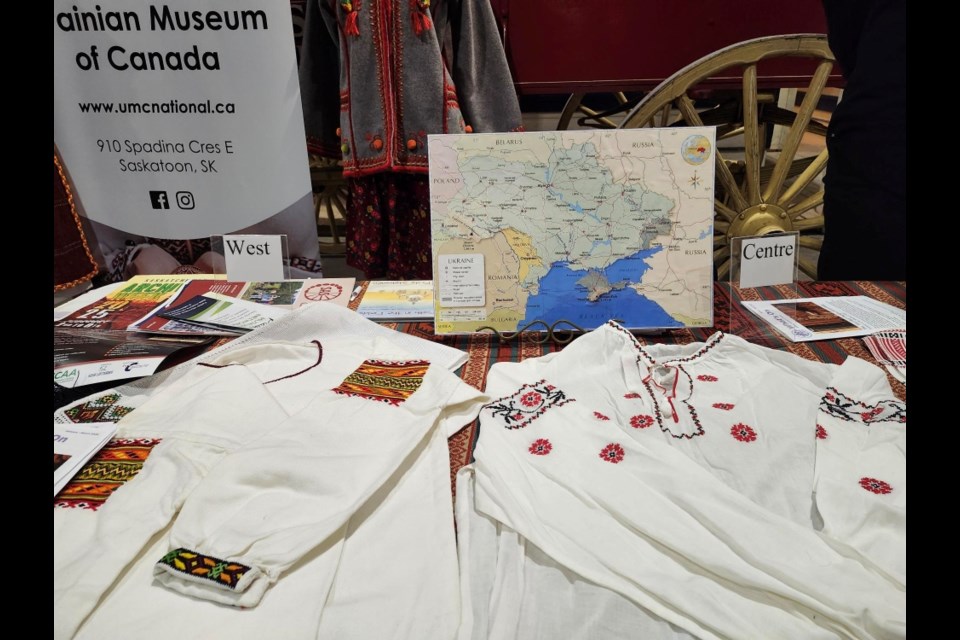SASKATOON — Ukrainian culture was well represented at the 37th annual Saskatoon Heritage Festival at the Western Development Museum on Feb. 2. A Ukrainian booth provided an opportunity to learn more about the Ukrainian community in Canada.
Ukrainians planted deep roots in Canada, with the first settlers reportedly arriving in the mid-to-late 1870s. Still, the first recorded wave of immigration was in 1891, with many settling in the Prairie provinces of Saskatchewan, Manitoba and Alberta. A 1901 census showed 5,862 Ukrainians in Canada, a number that ballooned to almost 1.3 million in 2021.
Saskatoon has the highest number of people of Ukrainian descent, close to 38,000. Many Ukrainians also settled in the rural communities of Bradwell, Canora, Hafford and Speers in Saskatchewan.
The Ukrainian community is one of the most active groups in the city, participating in festivals like the Saskatoon Folkfest or holding events that celebrate and promote their culture and heritage. On Sunday, a Ukrainian booth was one of 37 cultural exhibits at the Saskatoon Heritage Festival.
Among the displays in the booth was the vyshyvanka, the traditional hand-woven clothing worn by men and women, considered one of the most essential symbols of Ukrainian culture. However, the clothing differs in every region of Ukraine – from east to west, as Anastasia Misan, an assistant archivist at the Ukrainian Museum of Canada, explains.
“People from Ukraine want to show the respect they have on all of their work. They wanted to also show this through their clothing, which is why the colours are different in every city and region of Ukraine,” Misan told SaskToday, adding that one can learn more about Ukrainian culture and heritage at the Ukrainian Museum of Canada on Spadina Crescent East.
“I will start from Eastern Ukraine, where they are connected to the soil, as most were farmers. They wanted to show this on their clothing, which is why dark brown, dark red and black are the dominant colours. When you go to the central part, it is a bit brighter, where they add red and black colours to the white.”
She added that some cities and regions also use primarily black and white on their vyshyvanka, while those who live near the mountains use lighter shades.
“The people who live next to the mountains believe in the sun. The sun was … connected to religion. They believe sunrise and sunset represent death and birth. The colours are the same as the sunrise – red and orange, green and a bit of black,” said Misan.
“Their colours are usually brighter than those in the eastern part. We're coming from the darkest to the brightest colours. I'm from the Dnipropetrovsk region [southeastern Ukraine]; we have blue and dark blue colours, which is what I like to wear.”
She said design and embroidery also differ, as those who make the handmade clothing often include the letters of their names, and sometimes a bit of superstition is added.
“For example, if a woman makes a shirt for her husband, she will hide her hair in the sleeves for protection. It may sound weird now, but people believed this worked as protection during that time. She was praying for his safety, and he had a part of her, wearing it all the time,” Misan said.
She added that finishing a vyshyvanka depends on the piece, fabric and design, with some taking a week to complete and others up to three months or even half a year.
"It depends on how heavily it's embroidered. If you start from scratch, where you will make the fabric, it will take longer to finish. The fabric also differs depending on the region. Some vyshyvankas are thinner, and some are thicker. The embroidery was also different because some regions had white-on-white designs, which was pretty tough, especially during the early times when you only had candles as your light at night, which is impressive. So, I would say it starts from one week, but at maximum, it's half a year to finish,” said Misan.
“There were no patterns before. So, no one knew what they wanted for the design. It was more imagination. For example, one region mostly has flowers in its embroidery. But women are women. They want it to look prettier than other women. Sometimes, they copy the pattern from their friends. Most, however, try to be creative and make their own pattern, which is fun. Embroidery was a specific language, and it could be seen in their clothing. Now, you can’t tell which region people are from, unlike in ancient times, when you would know where they came from because every village and city had different patterns and colours.”




